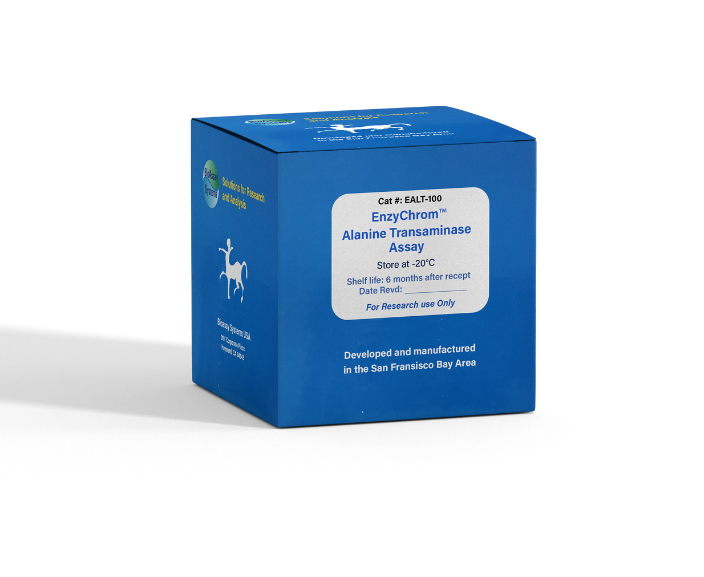DESCRIPTION
Alanine Transaminase (ALT), also known as serum alanine aminotransferase (ALAT) or pyruvic transaminase (SGPT), facilitates the conversion of alanine and α-ketoglutarate to pyruvate and glutamate. ALT plays an important role in gluconeogenesis and amino acid metabolism. ALT is found mainly in the liver, and, to a lesser extent, in kidney, heart, muscle, and pancreas tissues. Normal serum levels of ALT are low, and increased serum ALT activity is widely used as a marker for liver damage.
Simple, direct and automation-ready procedures for measuring ALT activity find wide applications in research and drug discovery. BioAssay Systems' ALT activity assay is based on the quantification of pyruvate produced by ALT. In this assay, pyruvate and NADH are converted to lactate and NAD by the enzyme lactate dehydrogenase (LDH). The decrease in NADH absorbance at 340 nm is proportional to ALT activity.
KEY FEATURES
Sensitive. Linear detection range: 2–100 U/L.
Simple and convenient. This simple, convenient assay can be carried out in a microplate or a cuvette and takes only 10 min.
APPLICATIONS
Direct Assays: ALT activity in serum, plasma and other biological samples.
Drug Discovery/Pharmacology: effects of drugs on ALT activity
KIT CONTENTS (100 TESTS IN 96-WELL PLATES)
Assay Buffer: 24 mL LDH: 120 µL
Cosubstrate: 600 µL NADH Reagent: Dried
Storage conditions. The kit is shipped on ice. Store all components at -20°C. Shelf life of six months after receipt, 3 weeks after reconstitution.
Precautions: reagents are for research use only. Normal precautions for laboratory reagents should be exercised while using the reagents. Please refer to Material Safety Data Sheet for detailed information.
ASSAY PROCEDURES
Equilibrate all components to room temperature. Reconstitute the NADH Reagent tube with 1000 µL dH2O (final 10 mM). Unused reconstituted NADH reagent is stable for three weeks when stored frozen at -20°C. Mix assay buffer well by vigorous shaking. Keep thawed enzyme on ice.
Assays can be performed at 37°C or at room temperature. Prior to assay, bring the working reagents, microplate and spectrophotometer to the desired temperature.
Assay is compatible with serum or plasma (heparin, EDTA). Samples should be clear and free of particles or precipitates. Hemolyzed samples should not be used.
Procedure using 96-well plate
1. Samples and controls. Transfer 20 μL of each sample to separate wells. Also, for each assay plate, include two wells with 20 μL dH2O to be used for the NADH Standard and Blank. Keep plate at the desired temperature (e.g. 37°C).
2. Prepare Working Reagent for Sample and Standard wells by mixing for each well: 200 μL Assay Buffer, 5 μL Cosubstrate, 1 μL LDH and 4 μL reconstituted NADH. Warm to desired temperature (e.g. 37°C). Prepare Blank Reagent for the Blank well by mixing: 200 μL Assay Buffer, 5 μL Cosubstrate, 1 μL LDH and 4 μL dH2O. Warm to desired temperature (e.g. 37°C).
3. Add 200 μL Working Reagent to each Sample and Standard well, and 200 μL Blank Reagent to the Blank well. Immediately tap plate to mix, incubate at the desired temperature and read OD340nm at 5 min and at 10 min. Alternatively, record kinetics at 340 nm.
Procedure using cuvettes
1. For each assay, include one Standard and one Blank control. For each Sample and Standard, prepare Working Reagent by mixing 1000 µL Assay Buffer, 25 µL Cosubstrate, 5 µL Enzyme Mix and 20 μL reconstituted NADH. Transfer 1000 µL Working Reagent to each sample cuvette and standard cuvette. Warm to desired temperature (e.g. 37°C). For Blank control, mix 1000 µL Assay Buffer, 25 µL Cosubstrate, 5 µL Enzyme Mix and 20 μL dH2O. Transfer 1000 µL Blank Reagent to the Blank control cuvette. Warm to desired temperature (e.g. 37°C).
2. Prewarm sample to the desired temperature. Add 100 μL Sample to the Sample Cuvette. Transfer 100 μL dH2O to the Standard cuvette and the Blank Control cuvette. Mix immediately.
3. Read OD340nm at 5 min and 10 min. Alternatively, record kinetics at 340 nm.
CALCULATION
For each Sample, calculate the rate of NADH consumption by subtracting the OD at 10 min from the OD at 5 min (∆ODS). Similarly, calculate the rate (∆ODNADH) for the NADH standard (OD5min - OD10min). Determine ALT activity using the following equation,
If the calculated ALT activity is higher than 100 U/L, dilute sample in Assay Buffer and repeat assay. Multiply results by the dilution factor.
Unit definition: 1 Unit (IU) of ALT will catalyze the conversion of 1 µmole of alanine to pyruvate per min at pH 7.7.
MATERIALS REQUIRED, BUT NOT PROVIDED
Pipeting devices and accessories. Clear bottom 96-well plates (e.g. Corning Costar) and plate reader or spectrophotometer and cuvettes for measuring OD340nm.
PUBLICATIONS
1. Andres-Hernando, et al (2020). Deletion of Fructokinase in the Liver or in the Intestine Reveals Differential Effects on Sugar-Induced Metabolic Dysfunction. Cell metabolism, 32(1), 117-127.
2. Xu, W. et al (2020). LyP-1-Modified Oncolytic Adenoviruses Targeting Transforming Growth Factor β Inhibit Tumor Growth and Metastases and Augment Immune Checkpoint Inhibitor Therapy in Breast Cancer Mouse Models. Human gene therapy, 31(15-16), 863-880.
3. Kamerkar, Sushrut, et al (2017). Exosomes facilitate therapeutic
targeting of oncogenic KRAS in pancreatic cancer. Nature 546.7659:
498.
